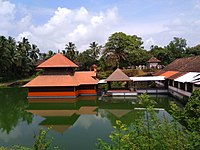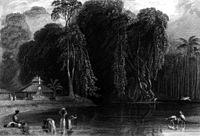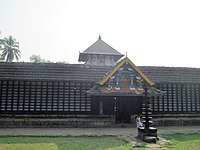Hinduism in Kerala
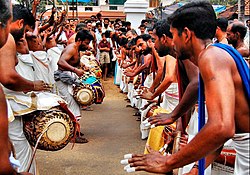 Panchavadyam (orchestra of 5 instruments) during a festival | |
| Total population | |
|---|---|
| 18,282,492 (2011) 54.7% of total population | |
| Religions | |
| Hinduism | |
| Languages | |
| Sacred Sanskrit Others | |
| Related ethnic groups | |
| Keralite Muslims and Keralite Christians |
Hinduism is the largest religion in Kerala and Hindu lineages together make up 54.7% of the population of the state according to the 2011 census.[1]
Background
[edit]Hinduism is the most widely professed faith in Kerala. According to 2011 Census of India figures, 54.7% of Kerala's residents are Hindus.[1] Hindus represent the biggest religious group in all districts except Malappuram.[2]
The legends regarding the origin of Kerala are Hindu in nature. Kerala produced several saints and movements.
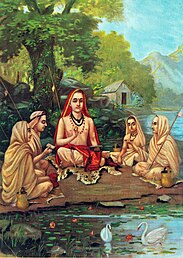
Adi Shankara was a religious philosopher who contributed to Hinduism and propagated the philosophy of Advaita. He was instrumental in establishing four mathas at Sringeri, Dwarka, Puri and Jyotirmath. Melpathur Narayana Bhattathiri was another religious figure who composed Narayaniyam, a collection of verses in praise of the Hindu God Krishna.
Various practises of Hinduism are unique to Kerala. Worship of Shiva and Vishnu is popular in Kerala. Lord Krishna is worshipped widely in all parts of Kerala, Guruvayur being one of the most famous temples in the state. Malayali Hindus also worship Bhagavathi as a form of Shakti. Almost every village in Kerala has a Bhagavati Goddess. Hindus in Kerala also strongly believe in power of snake gods and usually have sacred snake groves known as Sarpa Kavu near to their houses.
Malayali Hindus have ceremonies such as Chorunu (first feeding of rice to a child) and Vidyāraṃbhaṃ.
Demographics
[edit]Hindu population by district
[edit]| Districts | Population(2001) | Population(2011) | Hindu Population(2011) | Hindus % |
|---|---|---|---|---|
| Kasargod | 1,203,342 | 1,307,375 | 729,908 | 55.83% |
| Kannur | 2,412,365 | 2,523,003 | 1,509,513 | 59.83% |
| Wayanad | 786,627 | 817,420 | 404,460 | 49.48% |
| Kozhikode | 2,878,498 | 3,086,293 | 1,734,806 | 56.21% |
| Malappuram | 3,629,640 | 4,112,920 | 1,135,166 | 27.60% |
| Palakkad | 2,617,072 | 2,809,934 | 1,875,912 | 66.76% |
| Thrissur | 2,975,440 | 3,121,200 | 1,823,405 | 58.42% |
| Ernakulam | 3,098,378 | 3,282,388 | 1,509,570 | 45.99% |
| Idukki | 1,128,605 | 1,093,156 | 541,845 | 48.86% |
| Kottayam | 1,952,901 | 1,974,551 | 983,524 | 49.81% |
| Alappuzha | 2,105,349 | 2,127,789 | 1,460,515 | 68.64% |
| Pathanamthitta | 1,231,577 | 1,197,412 | 681,687 | 56.93% |
| Kollam | 2,584,118 | 2,635,375 | 1,697,709 | 64.42% |
| Thiruvananthapuram | 3,234,707 | 3,301,427 | 2,209,975 | 66.94% |
| Total | 31,841,374 | 33,406,061 | 18,282,492 | 54.9% |
| Source:[3] | ||||
Historical growth
[edit]| Census
Year |
Hindus | Decadal rate (%) | |
|---|---|---|---|
| 1901 | 8,978,305 | 68.5% | N/A |
| 1911 | 4,762,393 | 66.8% | -8.77 |
| 1921 | 5,052,039 | 64.9% | -6.08 |
| 1931 | 6,021,982 | 63.4% | -19.20 |
| 1941 | 6,699,600 | 61.8% | -11.25 |
| 1951 | 8,344,351 | 61.6% | -24.55 |
| 1961 | 10,282,568 | 60.9% | -23.23 |
| 1971 | 12,683,277 | 59.4% | -23.35 |
| 1981 | 14,901,347 | 58.2% | -16.70 |
| 1991 | 16,668,587 | 57.3% | -12.62 |
| 2001 | 17,920,105 | 56.3% | -7.51 |
| 2011 | 18,282,492 | 54.9% | -2.02 |
Hindu temples
[edit]-
A Hindu temple and pond associated with it in Kerala.
Some of the most notable temples are:
- Ananthapura Lake Temple
- Angadipuram
- Thirumandhamkunnu Temple
- Vairankode Bhagavathy Temple
- Alathiyoor Hanuman Temple
- Bhayankavu Bhagavathi Temple
- Kadampuzha Devi Temple
- Keraladeshpuram Temple
- Panniyur Sri Varahamurthy Temple
- Sukapuram Dakshinamoorthy Temple
- Thirunavaya Navamukunda Temple
- Triprangode Siva Temple
- Tali Shiva Temple
- Trikkandiyur Siva Temple
- Thrissur Vadakkunnathan Temple
- Guruvayur Temple
- Ambalappuzha Sree Krishna Swamy Temple
- Lokanarkavu Temple
- Thirunelli Temple
- Sabarimala Ayyappa Temple
- Thiruvananthapuram Padmanabhaswamy Temple
- Aranmula Parthasarathy Temple
- Chottanikkara Temple
- Chengannur Mahadeva Temple
- Parassinikadavu Muthappan Temple
- Parumala Valiya Panayannarkavu Devi Temple
- Chettikulangara Devi Temple
- Mannarasala Temple
- Chakkulathukavu Temple
- Sreevallabha Temple
- Kaviyoor Mahadevar Temple
- Sree Poornathrayesa Temple
- Kodungallur Bhagavathy Temple
- Vazhappally Maha Siva Temple
- Attukal Temple
- Trikkur Mahadeva Temple
- Rajarajeshwara Temple
- Kandiyoor Sree Mahadeva Temple
- Oachira Temple
Saints
[edit]Adi Shankara, the originator of Advaita Vedanta, was born in Kalady and was likely a Nambuthiri. Many Hindu saints and swamis from many castes have lived in Kerala. Sree Narayana Guru, Enadinatha, Ilakkulaccanrar, Tiruppana were all outside the Brahminical caste fold; Cheraman Nayanar was a Kothayar; and Chattampi Swamikal, Swami Sathyananda Saraswathi and Swami Chinmayananda, the Nair caste. The Parayas of Kerala claim descent from Vasishtha.[6] There is a shrine in Kollengode in memory of a lower-caste saint, Paakkanar.[7] The theatrical dance of Rapayan Tullal is narrated by a descendant of Pakkanar.[8] The Periya Puranam, possibly written by a Paraya, describes the Parayas.[9]
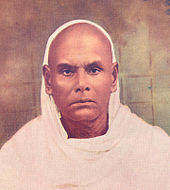
Swami Sathyananda Saraswathi is popularly regarded as the father of contemporary Hindu renaissance in Kerala for the victorious movements he led for temple rights and the establishment of Hindu Aikya Vedi for integrating people of all castes into one religion. He is reckoned as the greatest karmayogi to uphold Sanatana Dharma since Swami Vivekananda internationally. Sree Narayana Jayanti (Narayana Guru's birthday) and Sree Narayana Samadhi Day (the occasion of his samadhi) are public holidays in Kerala.
Mata Amritanandamayi, known among her devotees as Amma, was selected to represent the Hindu Dharma in the World Parliament of Religions in September 1991.[10] Bhagawan Nityananda was another important Hindu saint widely recognized.
Several Hindu movements important to the development of Hinduism took place in Kerala.[11] The Karppillikkavu Sree Mahadeva Temple, (one of the most ancient in India) dedicated to the Kirata Avatar of Lord Shiva still exists in Kerala.
Religious education
[edit]See also
[edit]References
[edit]- ^ a b "Population by religious communities". Census of India. Government of India. Archived from the original on 27 August 2015. Retrieved 26 August 2015.
- ^ "Increase in Muslim population in the State". The Hindu. Chennai, India. 23 September 2004. Archived from the original on 28 November 2004. Retrieved 13 November 2015.
- ^ "Vital Statistics Reports". Government of Kerala, Vital Statistics Division Department of Economics & Statistics Thiruvananthapuram. Archived from the original on 7 June 2016. Retrieved 1 June 2016.
- ^ Raghunath, Arjun (16 March 2016). "Kerala: Muslims will be double the number of Christians by 2051". Deccan Chronicle. Archived from the original on 19 March 2016. Retrieved 19 July 2021.
- ^ "Kerala population Demographics" (PDF). Bitscan. Retrieved 19 July 2021.
- ^ Dr. C. I. Issac, "The Origin of Syrian Christians of Keralam"
- ^ P. 94-5Tourist Guide to Kerala: The Land of Lavish Lagoons By V. Subburaj, Various
- ^ (Kr̥ṣṇavāriyar, P. 193 A History of Malayalam Metre)
- ^ Vishwakarma (Mahaprabhu.) (2000). Prachin Vishwakarma puran (in Gujarati). Harihar.
- ^ "Devotees flock to hug Indian guru" (BBC)
- ^ "Sri Vaishnava Divya Desam Shrines in Kerala". www.templenet.com. Retrieved 19 July 2021.
- ^ a b c Nambudiri, Sudha (11 June 2022). "Idolatry is a discipline". Times of India. Retrieved 26 July 2022.
External links
[edit]- "Religions in Kerala". ProKerala.

